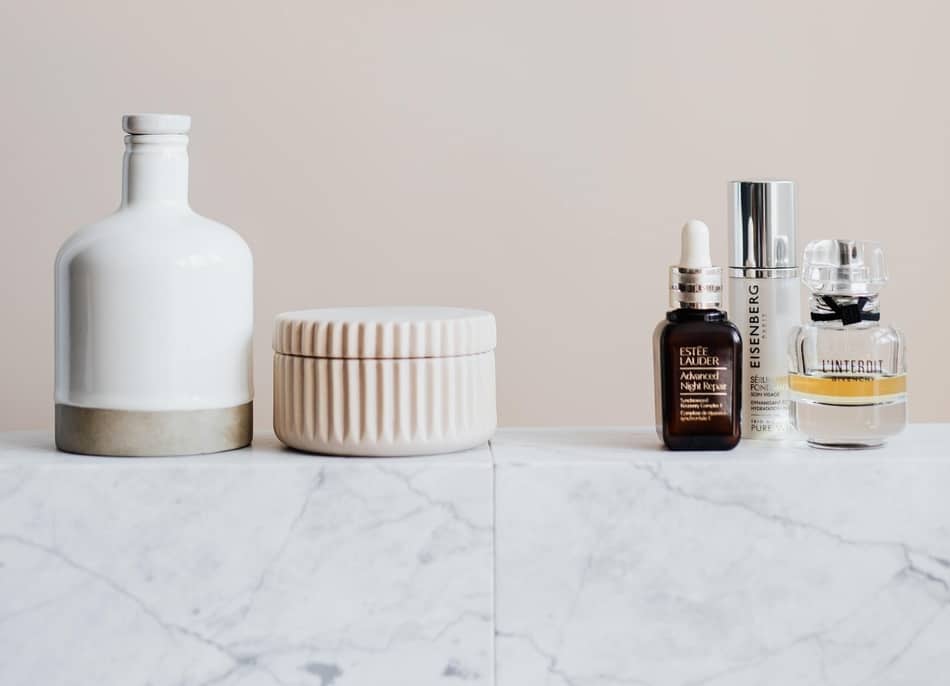Is your marble turning orange, yellow, or brown and you can’t seem to figure out what’s causing it? In this article, I researched why marbles discolor and I’m happy to share with you all my findings and some effective ways to remove the stains.
So why do marbles turn orange, yellow, or brown? Leaving a can of shampoo or shaving cream will leave an orange, or sometimes brown, or yellow rust stain on marble. Also, some marbles, especially, white marbles, contain high amounts of iron sulfide, and when the marble becomes wet for long periods of time the moisture will leach through the marble causing the iron sulfide deposits to oxidize creating an orange, yellow, or brown stain.
There are numerous ways marbles turn orange, yellow, or brown apart from what’s mentioned above. In the remaining parts of this article, I’m going to share with you some of the other possible ways your marble might be turning orange, brown, or yellow plus tips on some of the most effective ways to fix these types of stains on marbles.
1. Rusty Items On The Marble
This was probably your first guess when you saw the orange, yellow, or brown stain on your marble. Yes, your guess is right. This is one of the common causes or reasons why marbles develop orange, yellow, or brown stains. If you’re lost at this point, which I doubt you are, then let me break it down.
If you particularly have a light-colored marble countertop, centerpiece, or dining table and you happen to store or leave a can of shaving cream or anything similar on top of it and water gets underneath the can, then it’s going to leave discoloration that will often look like an orange, yellow, or brown ring stain.
If the rust stain has been left on the marble for a very long time, then the stain is going to seep into the marble and cause a permanent colored stain. These types of marble stains are usually extremely difficult to clean if not impossible.
Marbles are very gorgeous but one of their major downsides is that it stains very easily due to their highly porous nature. So never leave or store any sort of can on it.
2. High Iron Deposits Within The Marble
Chances are the orange, yellowish, or brownish stain you are having is on a light-colored marble usually white. White marbles like the Carrara marble contain high amounts of iron sulfide which is a natural mineral that comes with the material used for most white marbles.
So what happens is when the marble is exposed to water constantly, the water tends to find its way through the grout openings into the marble.
This then leaves room for the water and the iron contained in the marble to oxidize and as the rusty water evaporates it resurfaces creating an orange, yellow, or brown stain over the surface of the marble.
This will particularly happen if you have marble floor or wall installation, especially in steam showers – as steam showers allow moisture to permeate for long periods of time into the marble.
So the continuous exposure of the marble to steam or moisture reacts with the high levels of iron sulfide and boom, the colored stains begin to occur.
The yellow/orange/brown staining on your marbles will be worse if the moisture getting into the marble is somehow retained or if the moisture finds its way behind or under the marble.
This process normally happens over a long period of time with some exceptional cases of orange staining appearing quickly when it comes to thin marble tiles.
But before concluding this is what is happening with your marble, you would want to do a thorough check by possibly removing the marble to see what the underlying conditions are.
If this is impossible, as it’s often is with most marble installations, you could ask a professional to do a chemical analysis of the marble to see if it has too much iron sulfide in it and at what volume if possible.
You will particularly want to do this because not all marble minerals contain the same amounts of iron sulfide: some will have more while others will have less.
If this is going to be too much to ask, you can simply go through my hacks one after the other to see which one works for you.
3. High Iron Content In Your Water Pipelines
Another possible reason why your marble might be turning orange, yellow, or brown may be due to the high iron concentration in the water that runs through your pipelines.
If you live in a very old house apartment that physically looks like it’s been around for some time then chances are there will be some traces of iron in the water as its connection pipes may have developed rust due to age.
This would usually affect light-colored marbles the most. The way you will know if you have a high concentration of iron in your water supply will be to have the water or pipes checked or tested by a professional.
Another thing you can do if consulting a professional is a bit much to ask is to talk to the person you’re renting from (if you’re renting), the people who have been living there the longest, and might have witnessed one or two repairs.
Personally, what I do to check if my pipes have a high concentration of iron is to take a closer look at places on the marble (close the sink or marble floors or walls) where the water often runs or comes into contact with the marble.
What you would often see in most cases is some rust staining on the marble walls, countertops, or floor where water is often splattered or runs into your drain.
What you might also have is that the highly concentrated iron water could also combine with the high iron deposits that are often found in most light-colored marbles to cause this kind of coloring.
What a typical solution would be for high iron content in your water pipeline will be to filter the water that runs through your pipes to help remove as much of the iron in the water as possible and then use one of my recommended methods to remove the stains and use a good marble or granite sealer to seal off the marble surface.
You could also reseal any voids in the grout so that water does not get into and retained inside or underneath your marbles.
4. Poor Marble Installation
Poor marble installation is another way your marble can turn orange. It’s such a heartbreaking thing when you spend your hard-earned cash on an installation that sought to make your home look like the little paradise you deserve only to later find out there was a bad job done.
This is a classic example that can also cause your marble to turn orange, yellow, or brown discoloration. You will know this by how recurrent the stain is even after you have just cleaned it.
One of the common ways your installer may have wreaked havoc on your marble was by using the wrong kind of adhesive or setting material like cement instead of using white glue. Cement unlike white glue also contains iron that can subsequently cause something your marbles to yellow with time.
Or you could also have a plumbing leak that may be allowing water to get behind the marble causing the natural iron in the marble to oxidize and resurface as orange, yellow, or brown stain. This can cause the stain to be seriously recurrent.
While you may be able to use poultice to fix this type of problem, it’s only going to be a temporary fix. The rusty stain may continue to bleed through the marble as long as water continues to leak or the iron in the cement adhesive used continues to react with water.
A hard and painful permanent fix will be to tear the whole installation down and using the most suitable material possible to properly install the marble so that the marble is waterproof in wet conditions – but no need to worry as this will usually be the last resort.
5. Oils, Soaps And Shampoos
Marbles are great for bathrooms and kitchens but the nice smelling oils, shampoo, and soaps we use for our beautiful skin or washing utensils can be unfriendly to our marble installation.
This brings me to the 5th way marbles can be discolored. Which is, through oils, soaps, shampoos, and other health care products.
How? Your marbles will often develop stains from putting soaps and sponges on them. Also, the discoloration may also occur from the accumulation of soap lather and oils over a period of time.
There are certain ingredients in soaps and shampoos that can be responsible for the discoloration that occurs on marbles. This can be the oils or other chemicals used in the productions of such products.
What you will often notice is how centered this type of stain or discoloration is when compared to other parts of the marble. In most cases, this will be considered an oil stain or an organic stain on marbles by most professionals, and as such, an oil based-solution may be used.
In other instances, it will be more of soap scums rather than the ingredients in the soap itself. If you often leave your bar soaps on your marble, little bits and pieces of soap scum will begin to build up and the oils and colorants contained in the soap will begin to stain your marble. In such situations, your regular routine cleaning may not be able to get rid of such soap scums.
The good news is all of these types of stains are usually quite easy to fix using poultice – often an organic mixture of baking soda with water or sometimes lemon juice will do the trick.
What this type of fix will do is essentially absorb any staining chemicals, oils, soaps, or shampoos that may have deposited on the marble.
Another solution you can consider for soap scum or shampoo stain is to get a special marble cleaning product like this one from Amazon! With a little bit of scrubbing, you should be able to clean and get rid of the orange, yellow, or brown stain within a few simple steps.

